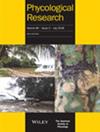日本 Nakaikemi 湿地两个同域 Epithemia(短叶藻类)类群细胞大小的差异缩小
IF 1
4区 生物学
Q2 MARINE & FRESHWATER BIOLOGY
引用次数: 0
摘要
我们观察到两种 Epithemia 类群的细胞大小发生了截然不同的时间变化。硅藻的生命周期与其细胞大小密切相关,细胞大小在无性生殖阶段逐渐减小,并通过有性生殖恢复。当细胞小于物种特有的尺寸阈值并接收到物种特有的环境线索时,就会触发有性生殖。很少有研究结合实地观察和实验室培养记录硅藻的生命周期和有性生殖频率。我们从中近海湿地的一个池塘中采集了两个硅藻类群,即 Epithemia gibba var. ventricosa 和 Epithemia sp.此外,我们还建立了这两个分类群的培养物,以研究影响无性阶段持续时间的细胞尺寸缩小率。在野外,E. gibba var. ventricosa表现出多种细胞大小和大小恢复迹象。此外,该分类群的培养物在分裂过程中细胞体积明显缩小,这表明体积恢复需要有性繁殖。另一方面,Epithemia sp.在野外和实验室中的细胞大小都没有明显变化。这表明,要么该分类群不需要有性繁殖来维持其种群数量,要么它们的生命周期长达数年至数十年。因此,我们的研究结果揭示了同源类群共享一个共同的栖息地和基质,但却表现出不同的有性和无性策略。此外,根据本研究中观察到的一系列形态特征,我们对以前对这些硅藻进行的分类的有效性提出了质疑。本文章由计算机程序翻译,如有差异,请以英文原文为准。
Differential cell size reduction of two sympatric Epithemia (Bacillariophyta) taxa in Nakaikemi Wetland, Japan
We observed contrasting temporal changes in cell size between two Epithemia taxa. The life cycle of diatoms is closely linked to their cell size, with a gradual decrease during the vegetative stage and a recovery through sexual reproduction. Sexual reproduction is triggered when cells become smaller than a species-specific size threshold and receive species-specific environmental cues. Few studies have documented the life cycles and frequency of sexual reproduction in diatoms, combining field observations and laboratory culture. We collected two Epithemia taxa, Epithemia gibba var. ventricosa and Epithemia sp. from a pond in Nakaikemi Wetland, and measured their valve lengths monthly for almost 3 years. Additionally, we established cultures of both taxa to examine the rates of cell size reduction, which affect the duration of the vegetative stage. In the field, E. gibba var. ventricosa exhibited a wide range of cell sizes and signs of size recovery. Furthermore, the cultures of this taxon showed a clear decrease in cell size through division, suggesting that sexual reproduction is required for size recovery. On the other hand, Epithemia sp. showed no obvious change in cell size both in the field and in the laboratory. This suggests that either sexual reproduction is not necessary for this taxon to maintain its population or their life cycle extends over several years to several decades. Thus, our findings reveal congeneric taxa sharing a common habitat and substratum, yet exhibiting distinct sexual and asexual strategies. Furthermore, we question the validity of taxonomic classifications previously assigned to these diatoms based on the range of morphological characteristics observed in the present study.
求助全文
通过发布文献求助,成功后即可免费获取论文全文。
去求助
来源期刊

Phycological Research
生物-海洋与淡水生物学
CiteScore
3.60
自引率
13.30%
发文量
33
审稿时长
>12 weeks
期刊介绍:
Phycological Research is published by the Japanese Society of Phycology and complements the Japanese Journal of Phycology. The Journal publishes international, basic or applied, peer-reviewed research dealing with all aspects of phycology including ecology, taxonomy and phylogeny, evolution, genetics, molecular biology, biochemistry, cell biology, morphology, physiology, new techniques to facilitate the international exchange of results. All articles are peer-reviewed by at least two researchers expert in the filed of the submitted paper. Phycological Research has been credited by the International Association for Plant Taxonomy for the purpose of registration of new non-vascular plant names (including fossils).
 求助内容:
求助内容: 应助结果提醒方式:
应助结果提醒方式:


